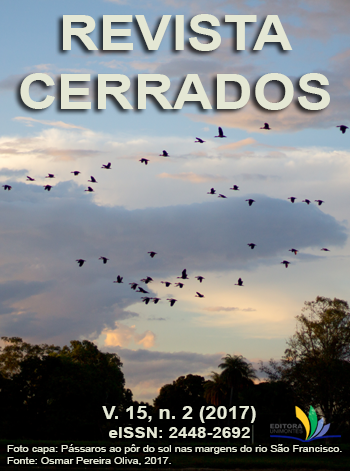Análise da evolução do uso da terra e conflitos relacionados à conservação das áreas úmidas na bacia do Ribeirão Bom Jardim, em Uberlândia/MG
DOI:
10.22238/rc24482692v15n22017p181a200Palavras-chave:
Legislação ambiental; Uso da terra; Áreas úmidas.Resumo
A análise da evolução do uso da terra através de técnicas de sensoriamento remoto contribui para a compreensão das transformações socioambientais de uma determinada área. O presente artigo apresenta resultados de pesquisa dedicada a avaliar as transformações no uso e ocupação da terra na bacia hidrográfica do Ribeirão Bom Jardim, em Uberlândia/MG, nos últimos 30 anos. O quadro de transformações no uso da terra é avaliado com ênfase nos debates pertinentes à preservação das áreas úmidas (AUs). Através de revisão bibliográfica e mapeamento utilizando imagens da série de satélites Landsat, foram constatadas as transformações e apresentadas recomendações. Verificou-se redução próxima de 12% das áreas naturais, sobretudo do bioma Cerrado, e aumento acima de 21% das áreas antropizadas ocupadas por cultura anual, o que impactou sobremaneira as Áreas de Preservação Permanente, incluindo as áreas úmidas.
Downloads
Referências
BACCARO, C. A. D. Estudo dos processos geomorfológicos de escoamento pluvial em área de Cerrado – Uberlândia – MG. EDUSP, São Paulo, 1990.
BRASIL. CONSELHO NACIONAL DE RECURSOS HÍDRICOS - CNRH. PLANO NACIONAL DE RECURSOS HÍDRICOS: Prioridades 2012-2015. Brasília, 2011. 153 p.
BRASIL. Decreto nº 1905, de 16 de maio de 1996. Promulga A Convenção Sobre Zonas Úmidas de Importância Internacional, Especialmente Como Habitat de
Aves Aquáticas, Conhecida Como Convenção de Ramsar, de 02 de Fevereiro de 1971. Brasília, DF: Diário Oficial da União, 17 maio 1996.
BRASIL. Lei nº 4771, de 15 de setembro de 1965. Institui O Novo Código Florestal. Brasília, DF: Diário Oficial da União, 16 set. 1965.
BRASIL. Lei nº 6938, de 31 de agosto de 1981. Dispõe Sobre A Política Nacional do Meio Ambiente, Seus Fins e Mecanismos de Formulação e Aplicação, e Dá Outras Providências. Brasília, DF: Diário Oficial da União, 02 set. 1981.
FELTRAN FILHO, A. A estruturação das paisagens nas chapadas do Oeste Mineiro. São Paulo: USP/FFLCH, 1997 (Tese de Doutorado)
INPE. Divisão de Geração de Imagens: Os satélites LANDSAT 5 e 7. Disponívem em:< http://www.dgi.inpe.br/Suporte/files/Cameras-LANDSAT57_PT.php>, acesso em 07 de março de 2017. [s. d.]
JUNK, W. et al. Definição e classificação das Áreas Úmidas (AUs) brasileiras: base científica para uma nova política de proteção e manejo sustentável. Cuiabá: CPP/INAU, 2012.
JUNK, W. J.; BAYLEY, P. B. ; SPARKS, R. E. . The Flood Pulse Concept in River Floodplain Systems. Canadian Journal of Fisheries and Aquatic Sciences, Canada, v. 106, p. 110-127, 1989.
MACHADO, H. A.. Comportamento do carbono orgânico em áreas úmidas do Cerrado: Estudo de caso em uma área úmida do Córrego Beija-Flor, Uberlândia/MG. 2014. 90 f. Dissertação (Mestrado) - Curso de Geografia, Instituto de Geografia, Universidade Federal de Uberlândia, Uberlândia, 2014.
MINAS GERAIS (Estado). Lei nº 20922, de 16 de outubro de 2013. Dispõe Sobre As Políticas Florestal e de Proteção à Biodiversidade no Estado. Minas Gerais, MG: Minas Gerais Diário do Executivo, 17 out. 2013.
MINAS GERAIS (Estado). Lei nº 9375, de 12 de dezembro de 1986. Declara de Interesse Comum e de Preservação Permanente Os Ecossistemas das Veredas no Estado de Minas Gerais. Minas Gerais, MG: Minas Gerais Diário do Executivo, 13 dez. 1986.
MMA. Sítios Ramsar: Sítios Ramsar do Brasil. [s. a.]. Disponível em: <https://goo.gl/BXhdxE>. Acesso em: 7 mar. 2017.
NOVO, E. M. L. de M. Sensoriamento Remoto: princípios e aplicações. São Paulo: Blucher, 2008, 363 p.
NUNES DA CUNHA, C. ; PIEDADE, M. T. F. ; JUNK, W. J.. Classificação e Delineamento das Áreas Úmidas Brasileiras e de seus Macrohabitats. 1. ed. Cuiabá: EdUFMT, 2015. v. 1. 156p
RAMSAR. Convenção sobre Zonas Úmidas de Importância Internacional, especialmente como Habitat para Aves Aquáticas. Ramsar, Irã, 1971. Disponível em: http://www.ramsar.org/cda/en/ramsar-documents-texts-conventionon/main/ramsar/1-31-38%5E20671_4000_0__
RESENDE, Thalita Mendes; ROSOLEN, V. Degradação do Solo pela Conversão do Cerrado em Pastagem Natural na Bacia do Ribeirão Bom Jardim (Triângulo Mineiro / MG). Ateliê Geográfico (UFG), v. 5, p. 118-134, 2011.
ROSA, R. Introdução ao Sensoriamento Remoto. Uberlândia: EDUFU, 7ª ed, 2009, 64 p.
SANTOS, R. F. Livro Planejamento Ambiental: teoria e prática, ed. Oficina de Textos–São Paulo, v. 184, 2007.
SCHNEIDER, M. O. Bacia do Rio Uberabinha: uso agrícola do solo e meio ambiente. São Paulo: USP/FFLCH, 1996.
Publicado
Como Citar
Edição
Seção
Licença
Copyright (c) 2017 Revista Cerrados

Este trabalho está licenciado sob uma licença Creative Commons Attribution-NonCommercial-NoDerivatives 4.0 International License.
Nesta Revista, os Direitos Autorais para artigos publicados são do(s) autor(es), sendo os direitos da primeira publicação pertecentes à Revista Cerrados. Os artigos são de acesso público, de uso gratuito, de atribuições próprias, de atribuições educacionais e de aplicações não comerciais.


















